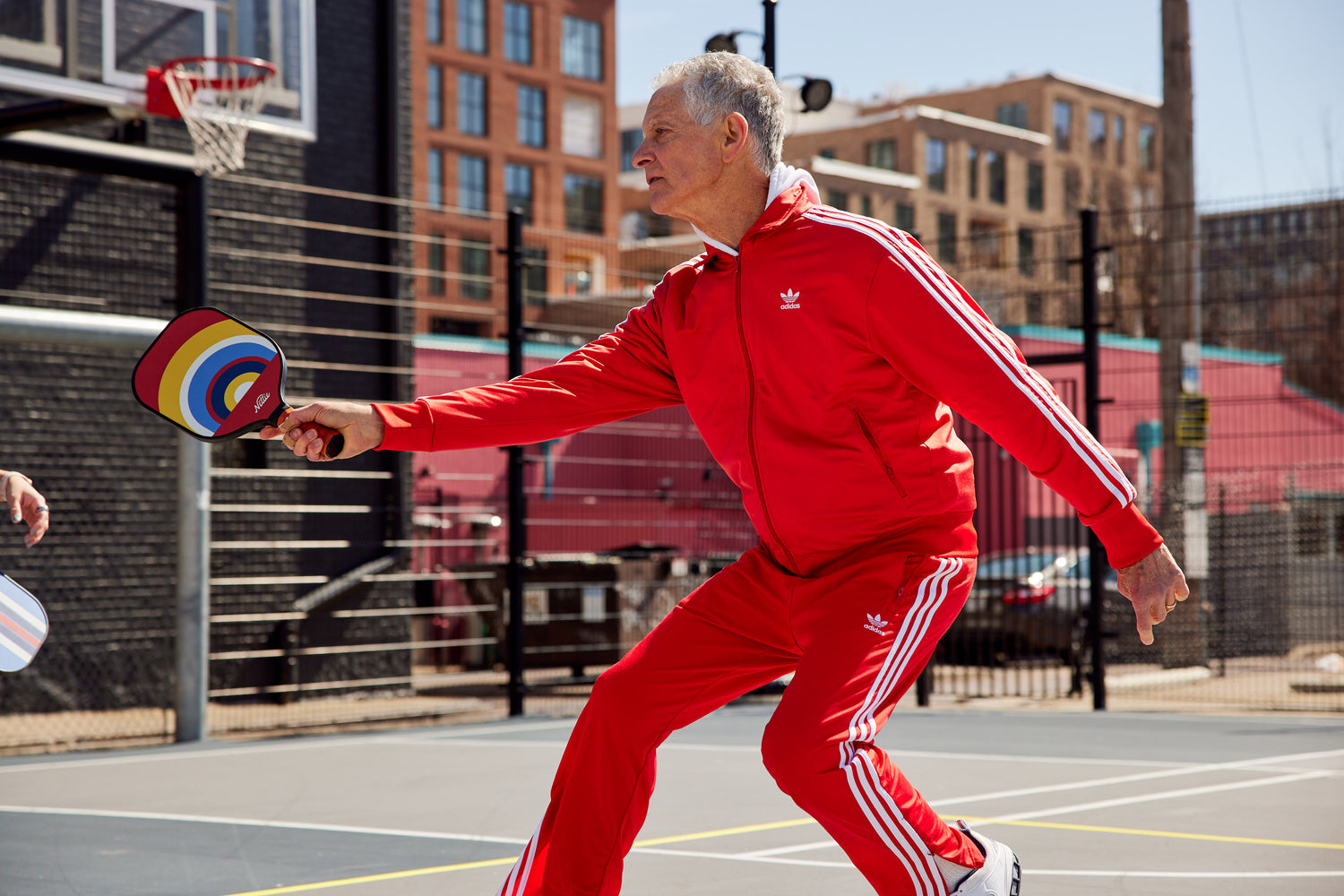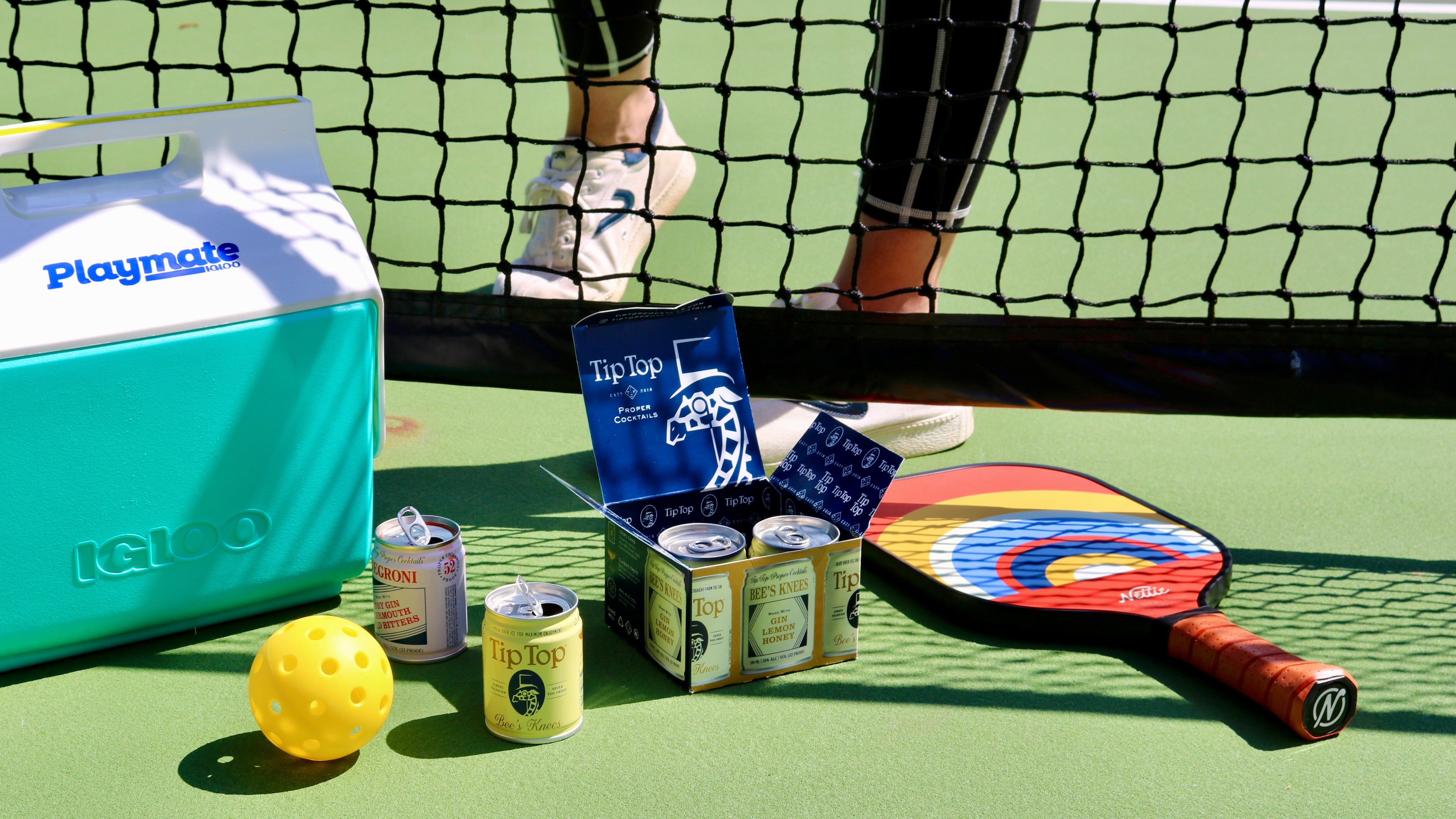Presented by brrrn board!
1. Arm Circles
You can’t hit a pickleball without relying upon your upper body—specifically your shoulders. The shoulder joint is very mobile and therefore is unstable and prone to injury. Pickleball players should opt for exercises that improve the shoulder stability and strength in all three planes of motion. Arm circles are a great exercise to include in a warm up, as it stabilizes the muscles around the shoulder to improve mobility and activate the muscles prior to physical activity.
- Place the mitts over your hands. Facing the Brrrn Board lengthwise, get into a high plank position with your hands in the middle of the board’s deck. Make sure that your wrists are directly beneath your shoulders.
- Starting with your right arm, move your hand in a clockwise motion to make a complete circle.
- Next, move your left hand in a counterclockwise motion to make another circle.
- Repeat, alternating sides and aiming for nice even circles. Keep your hips still and maintain correct plank form. To scale down, place your knees down on the floor to be in a modified plank position.
Repeat for 30 seconds. Rest for 15 seconds in between sets, and complete 3 sets total.
2. Elbow Plank Pikes
If you watch a pickleball match, you’ll probably notice that most of the players seem to be hunched over, which over time, can cause players to experience lower back pain. To avoid this, players should always keep their bodies in neutral alignment, which can be achieved by strengthening their core muscles and bringing awareness to their posture. Elbow plank pikes activate the deep core muscles, the transverse abdominis, as well as the obliques. This exercise requires proper plank form, so it is crucial to avoid any anterior or posterior pelvic tilt causing the lower back to arch.
- Begin in an elbow plank position, with your elbows and forearms off the board, in front of the bumper. Bring your feet together on the board. Press back through your heels, engage your glutes, and maintain a neutral spine with shoulders over your elbows.
- Inhale, and as you exhale, bring your hips up as you slide your feet in toward your elbows. Keep your legs as straight as possible.
- Inhale as you slide your feet back and lower your hips back down to starting position.
- Repeat. Aim for a 2:2 tempo: two seconds of controlled piking up and two seconds of controlled lowering down. Remember to exhale as you pike up and inhale as you return to plank.
Repeat for 30 seconds (progressing to 45 and 60 seconds when ready). Rest for 15 seconds in between sets, and complete 3 sets total.
3. Lateral Lunges
Many pickleball players experience ankle and foot injuries, such as sprains, plantar fasciitis, and Achilles tendonitis. To avoid these injuries, players should work on strengthening their foot and ankle muscles. The ankle joint can move in multiple planes of motion, but we tend to only move it in the sagittal plane (aka. forward and backwards movements). Keeping ankles mobile is very important but often ignored in strength training. When ankles are not as mobile and/or stable, it can lead to injuries such as plantar fasciitis or Achilles tendonitis. When playing pickleball, weak ankles can make it difficult to safely pivot or change directions quickly. Lateral lunges are a fundamental strength exercise in the frontal plane that can increase the strength and mobility of your ankles. Like sliding on a Brrrn Board, lateral lunges improve balance, stability, and proprioception with muscles, tissues, tendons, and ligaments around the ankle joint.
- Begin with your right foot off of the board and your left foot on the board. Both feet should be snug against the bumper. Place all your weight in your right heel.
- Bend your right knee as you send your hips down and back while sliding your left foot out to the side on the board. Keep your left leg straight.
- To return to the standing position, press up through your right heel and slide your left toes back in towards the bumper. keep your toes pointing forward to avoid knee issues, and maintain a neutral spine throughout the movement. Inhale as you lower down, and exhale as you stand back up.
Complete 15 reps on each side. Do 3 sets total.
4. Sprinter Slides
Being a conditioned player can significantly improve your pickleball game. By incorporating a low-impact, frontal plane dominant exercise like Sprinter slides, players can improve their cardiorespiratory fitness as well as their range of motion and stability in the joints prone to pickleball injuries (i.e. hips, knees, and ankles). As mentioned previously, many pickleball players are not used to sudden changes in direction in the frontal plane (aka. Side-to-side movements). By incorporating Sprinter slides into your warm up, players will condition their bodies to move laterally and prepare them for dynamic movements on the court. On top of that, sprinter slides increase balance and coordination, and they can help pickleball players get in the habit of maintaining a neutral spine while moving.
Just because of its name, you won't actually be sprinting at first when doing sprinter slides! Begin at your own pace, and slowly increase your cadence once you feel ready.
- Begin with both feet on the board together, snug against the left bumper. Bend your knees, keeping your shoulders back and chest open. Pick up your inner foot and push off of the bumper with your outer foot to slide across the board’s deck. Make sure your feet touch once you reach the right side.
- Repeat, sliding back and forth while staying low.
- Move your arms naturally with you, as you would while walking or running. For example, when sliding to the left, your right arm will move with you as added momentum.
Repeat for 30 seconds (progressing to 45 and 60 seconds when ready). Rest for 15 seconds in between sets, and complete 3 sets total.
5. Tap Slides
Pickleball is both a multi-generational and multi-directional sport. Unfortunately, most players have become accustomed to only exercising their bodies in a single plane of motion—the sagittal plane (aka. forward and backward movements). With a sport like pickleball, your body is required to move in all three planes of motion (sagittal, frontal, and transverse). Therefore your exercise routine should include movements in all three planes of motion to avoid injuries and improve your performance (both on and off the court). Knee strains are a common pickleball injury because players may not be conditioned to quick changes of direction. To avoid knee strains and knee ligament injuries, it’s important to incorporate exercises in the transverse and frontal planes to stabilize the knee and the muscles around it.
That’s why Tap Slides are a great low-impact exercise to include in both your warm up and in your weekly fitness regime This one move hits all three planes of motion all at once and recruits both the dynamic and static stabilizers in the knees. As a bonus, this move can improve your cardiovascular endurance for a better pickleball game!
- Begin with both feet on the board together, snug against the left bumper. Bend your knees a little. As you pick up your inner foot, push off of the bumper with your outer foot to slide across the board’s deck.
- As you slide across, begin to squat down and tap the right bumper with your left hand.
- Repeat, now sliding back over to the left bumper and squatting down to tap it with your right hand. Continue sliding back and forth, tapping the bumper with your opposite hand each time. Make sure that both your feet come together at the bumper after each slide.
- As you slide across the board, come up just a little bit before returning to your low squat at either bumper. If you are unable to reach the bumper with your hands, aim for your knees or shins until you can reach lower while maintaining proper form. It is important to keep a neutral spine throughout this movement. Keep your chest open and shoulders back.
Repeat for 30 seconds (progressing to 45 and 60 seconds when ready). Rest for 15 seconds in between sets, and complete 3 sets total.









